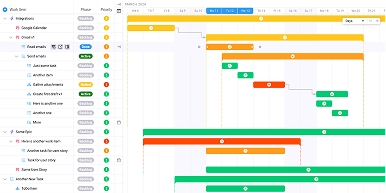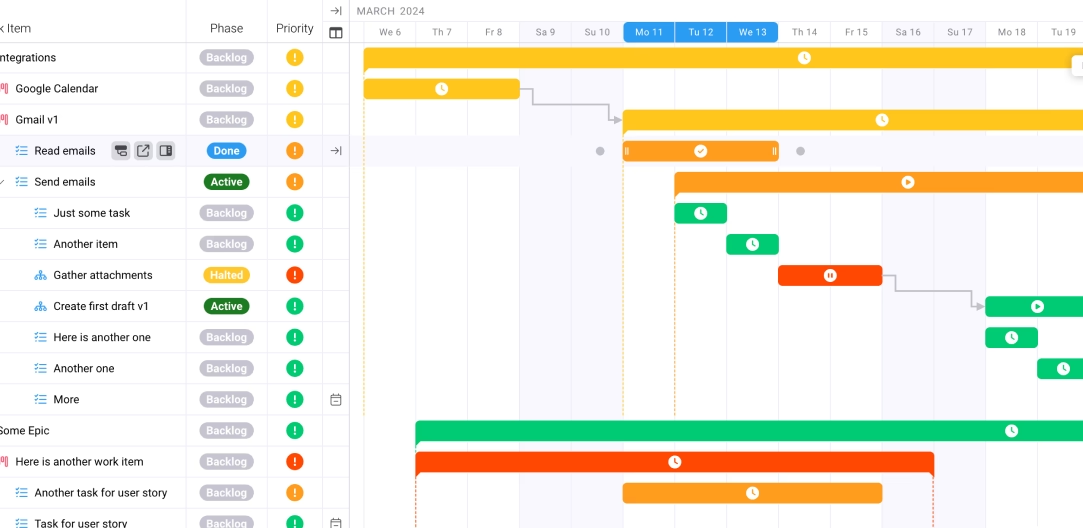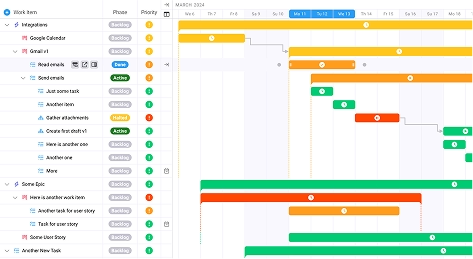
The Ultimate Guide to Agency Resource Planning
Key takeaways:
- Strategic Integration: Modern agency resource planning requires integration with business strategy and financial planning, moving beyond traditional HR-only approaches
- Data-Driven Decision Making: Successful agencies leverage real-time utilization metrics and predictive analytics to optimize resource allocation across projects and teams
- Technology Enablement: Advanced resource planning platforms provide visibility into capacity, skills gaps, and performance metrics that spreadsheets cannot match
- Continuous Optimization: Leading agencies treat resource planning as an ongoing process rather than a periodic activity, enabling rapid response to market changes
The contemporary agency landscape has fundamentally shifted. Where traditional resource allocation once relied on intuition and spreadsheet-based planning, today’s successful agencies leverage strategic workforce planning to navigate unprecedented market volatility. Agency resource planning has evolved from a quarterly exercise to a continuous, data-driven process that directly impacts profitability and competitive advantage. The stakes have never been higher—agencies that master resource planning thrive, while those clinging to outdated methods struggle to survive in an environment where business disruption has increased 260% in the past five years.
The Current Challenge: What’s Broken in Agency Resource Management
The agency industry faces a perfect storm of challenges that traditional resource planning methods cannot address. Recent research reveals that only 10% of agency professionals described 2024 as healthy for their business, with 44% characterizing it as a struggle. This harsh reality stems from multiple converging factors that have exposed fundamental weaknesses in how agencies plan and allocate their most valuable asset: human talent.
Economic uncertainty has emerged as the top concern for agencies in 2024, directly impacting resource planning decisions. The traditional approach of reactive staffing—hiring when work comes in and reducing staff when projects end—has proven inadequate in an environment where client acquisition costs continue rising while project margins shrink. Agencies are caught between the need to maintain skilled teams for competitive advantage and the pressure to minimize overhead costs during uncertain economic periods.
The challenge is compounded by a significant talent retention crisis. Research shows that 26% of agencies lost more than 10% of their staff in the first half of 2024 alone. This attrition rate creates a dual problem: agencies lose institutional knowledge and specialized skills while simultaneously facing increased costs to replace departed team members. The traditional resource planning approach—which assumes stable staffing levels—breaks down when faced with such volatility.
Limited visibility into actual resource utilization represents another critical gap. Many agencies still rely on spreadsheet-based planning that provides little insight into real-time capacity, project profitability, or individual performance metrics. This lack of visibility makes it impossible to identify inefficiencies, optimize team allocation, or make data-driven decisions about future hiring needs. The result is a reactive management style that constantly puts agencies behind market demands rather than positioning them to capitalize on opportunities.
The Strategic Framework: Building Modern Agency Resource Planning
Effective agency resource planning requires a fundamental shift from tactical staffing to strategic workforce management. This transformation begins with recognizing that resource planning is not merely an operational function but a core business capability that directly influences competitive advantage, profitability, and growth potential.
The foundation of modern resource planning lies in strategic workforce planning that integrates talent strategy with business objectives. This approach moves beyond traditional role-based planning to focus on skills, capabilities, and capacity alignment with strategic goals. Leading agencies adopt a three-to-five-year planning horizon that anticipates market changes, technology evolution, and client needs rather than simply responding to immediate project demands.
Skills-based resource planning represents a paradigm shift from the conventional approach of filling predetermined roles. Instead of hiring for specific positions, forward-thinking agencies identify the skills and capabilities required to deliver their strategic objectives, then determine the optimal combination of full-time employees, contractors, and external partners to meet these needs. This approach provides greater flexibility to adapt to changing market conditions while ensuring critical capabilities remain available when needed.
Data integration across business functions forms the backbone of effective resource planning. The most successful agencies break down silos between project management, financial planning, and human resources to create a unified view of resource allocation and performance. This integration enables real-time visibility into project profitability, team utilization, and capacity planning that supports both immediate tactical decisions and long-term strategic planning.
Technology enablement through modern workforce planning platforms provides the analytical capabilities necessary for sophisticated resource management. These platforms go beyond basic scheduling to offer predictive analytics, scenario planning, and automated reporting that support data-driven decision making. The goal is not to replace human judgment but to provide leaders with the information necessary to make informed choices about resource allocation and strategic direction.
Implementation Tactics: Optimizing Resource Allocation for Agency Success
Successful implementation of modern resource planning requires a systematic approach that addresses both immediate operational needs and long-term strategic objectives. The following tactics provide a roadmap for agencies seeking to optimize their resource allocation and improve overall performance.
Establish Baseline Metrics and Benchmarking
The first step in optimizing resource allocation involves establishing clear baseline metrics that provide insight into current performance. Leading agencies track multiple utilization metrics beyond simple billable hours, including project profitability, skill utilization, and capacity forecasting. Industry benchmarks suggest that successful agencies maintain utilization rates between 70-80%, but the specific target varies based on agency size, service mix, and market positioning.
Effective benchmarking extends beyond internal metrics to include competitive analysis and market positioning. Agencies must understand how their resource costs, service delivery speed, and quality measures compare to both direct competitors and alternative service providers. This external perspective helps identify areas where resource reallocation can create competitive advantages or address market vulnerabilities.
Implement Dynamic Capacity Planning
Traditional capacity planning assumes static resource requirements and predictable project timelines—assumptions that rarely hold true in the dynamic agency environment. Modern capacity planning incorporates variable demand forecasting, skills-based allocation, and scenario planning to create more resilient resource strategies.
Dynamic capacity planning requires integration of project pipeline data, historical performance metrics, and market trend analysis to create rolling forecasts that adapt to changing conditions. This approach enables agencies to identify potential resource conflicts weeks or months in advance, allowing time to adjust team allocation, hire specialized talent, or negotiate project timelines with clients.
The most sophisticated agencies use predictive analytics to model multiple scenarios and their resource implications. These models help leaders understand the trade-offs between different strategic choices and identify the optimal resource allocation for various market conditions. The goal is to maintain flexibility while ensuring critical capabilities remain available when needed.
Optimize Team Structure and Skills Mix
Effective resource planning goes beyond headcount to focus on the optimal mix of skills, experience levels, and employment models needed to deliver strategic objectives. Research shows that focusing on “A positions” rather than just “A players” creates more sustainable competitive advantages by ensuring critical roles have the support and resources necessary for success.
Skills-based team optimization involves analyzing project requirements, client needs, and market trends to identify the specific capabilities that drive value creation. This analysis helps determine where agencies should invest in full-time expertise versus leveraging contractors or external partners. The most successful agencies maintain core competencies in-house while building flexible networks of specialized talent for projects requiring unique skills.
Cross-functional collaboration becomes essential when optimizing team structures. Strategic workforce planning requires input from project managers, account leads, and senior leadership to ensure resource allocation decisions support both client delivery and business development objectives.
Leverage Technology for Real-Time Resource Management
Modern resource planning requires sophisticated technology platforms that provide real-time visibility into team capacity, project status, and performance metrics. These systems move beyond basic time tracking to offer comprehensive resource management capabilities including skills inventory, capacity forecasting, and performance analytics.
The most effective platforms integrate multiple data sources to provide a unified view of resource allocation across projects, clients, and time periods. This integration enables managers to identify optimization opportunities, prevent resource conflicts, and make data-driven decisions about team allocation and project planning.
Automation capabilities within these platforms help reduce administrative overhead while improving accuracy and consistency of resource planning processes. Automated reporting, capacity alerts, and performance dashboards free managers to focus on strategic decisions rather than manual data collection and analysis.
Measuring Success: KPIs and Metrics That Matter
Effective resource planning requires comprehensive measurement systems that track both operational efficiency and strategic progress. The most successful agencies develop balanced scorecards that monitor leading and lagging indicators across multiple dimensions of resource performance.
Utilization and Efficiency Metrics
Resource utilization remains the fundamental metric for agency performance, but modern measurement approaches go beyond simple billable hour calculations. Effective agencies track multiple utilization metrics including project-specific utilization, skill-based utilization, and capacity utilization to gain comprehensive insight into resource performance.
Billable utilization measures the percentage of available time spent on client work, with industry benchmarks ranging from 70-80% for most successful agencies. However, this metric must be balanced with quality measures and employee satisfaction scores to ensure high utilization rates don’t compromise service delivery or team sustainability.
Efficiency metrics extend beyond utilization to examine how effectively resources are deployed across different types of work. These metrics include project profitability ratios, time-to-completion comparisons, and quality indicators that help identify where resource reallocation can improve overall performance.
Financial Performance Indicators
Resource planning directly impacts financial performance through multiple channels including labor costs, project profitability, and revenue optimization. Leading agencies track revenue per employee, gross margin by service line, and labor cost ratios to understand how resource decisions affect financial outcomes.
Project profitability analysis provides insight into which types of work generate the highest returns and require the most effective resource allocation. This analysis helps agencies identify where they should focus business development efforts and how to structure teams for optimal financial performance.
Cost management metrics include both direct labor costs and overhead allocation to understand the true cost of resource deployment. These metrics help agencies make informed decisions about pricing, team structure, and service delivery models that optimize financial performance while maintaining competitive positioning.
Strategic Progress Metrics
Beyond operational efficiency, effective resource planning supports strategic objectives including market expansion, capability development, and competitive positioning. Strategic metrics include skill development progress, client satisfaction scores, and market share indicators that demonstrate how resource investments support long-term objectives.
Capability development metrics track the agency’s progress in building strategic skills and competencies needed for future growth. These metrics help ensure that resource planning decisions support long-term competitive advantage rather than just short-term operational efficiency.
Future Considerations: Emerging Trends and Next Steps
The agency resource planning landscape continues evolving rapidly, driven by technological advancement, changing client expectations, and market dynamics. Successful agencies must anticipate these trends and adapt their resource planning strategies to remain competitive in an increasingly complex environment.
Artificial Intelligence and Automation Impact
Artificial intelligence is reshaping workforce planning across industries, and agencies are no exception. AI-powered tools are beginning to automate routine tasks, change skill requirements, and create new opportunities for service delivery. Resource planning must account for these changes by identifying which roles will be augmented by AI, which skills will become more valuable, and how team structures need to evolve.
The integration of AI into agency operations creates opportunities to reallocate human resources toward higher-value activities while automating routine tasks. However, this transition requires careful planning to ensure teams develop the skills necessary to work effectively with AI tools while maintaining the creative and strategic capabilities that differentiate agency services.
Predictive analytics powered by AI enable more sophisticated resource planning by analyzing historical project data, market trends, and client behavior patterns to forecast future resource needs. These capabilities help agencies move from reactive to proactive resource management, identifying potential challenges and opportunities before they impact operations.
Flexible Workforce Models
The traditional model of full-time, permanent employees is giving way to more flexible workforce structures that combine employees, contractors, and external partners. This evolution requires resource planning systems that can manage diverse employment relationships while maintaining service quality and client satisfaction.
Hybrid workforce models enable agencies to maintain core competencies in-house while accessing specialized skills through external networks. This approach provides greater flexibility to adapt to changing client needs while managing overhead costs. However, it requires sophisticated coordination and management capabilities to ensure seamless service delivery across different employment models.
Sustainability and Social Responsibility
Growing emphasis on environmental and social responsibility is influencing resource planning decisions as clients increasingly value agencies that demonstrate commitment to sustainable business practices. This trend affects everything from office space planning to travel policies and remote work arrangements.
Resource planning must now consider factors beyond traditional efficiency metrics to include environmental impact, employee wellbeing, and social responsibility objectives. Leading agencies are developing metrics and planning processes that balance operational efficiency with broader stakeholder interests.
Conclusion: Mastering Agency Resource Planning for Sustainable Growth
The future belongs to agencies that master the art and science of resource planning. As market volatility increases and client expectations continue evolving, the ability to optimize resource allocation becomes a fundamental competitive advantage. Agency resource planning has evolved from a administrative function to a strategic capability that determines which agencies thrive and which struggle to survive.
The most successful agencies recognize that effective resource planning requires integration across business functions, sophisticated technology platforms, and a commitment to continuous improvement. They move beyond reactive staffing decisions to embrace strategic workforce planning that anticipates market changes and positions their organizations for sustainable growth.
The transformation from traditional resource management to modern workforce planning is not optional—it’s essential for agency survival and success. Organizations that invest in developing these capabilities today will be positioned to capitalize on opportunities while their competitors struggle with outdated approaches. “The Ultimate Guide to Agency Resource Planning” provides the framework, but the commitment to implementation and continuous improvement determines ultimate success.
Ready to transform your agency’s resource planning capabilities? Explore how Ravetree can provide the visibility and control needed to optimize your most valuable asset—your team.









